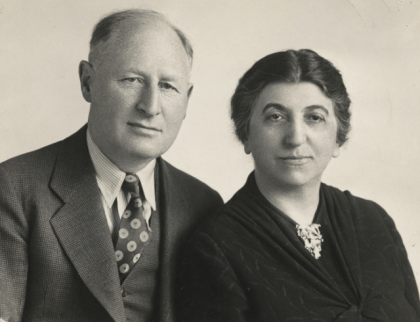
Arthur and Fanny Brin
In 1912, Arthur Brin founded a legacy that would outlast two world wars, multiple economic crises, and a global pandemic. More than one hundred years later, Brin Glass stands as a testament to the importance of loyal leadership, hard-working teams, and a passion for growth. Boasting more than a family name; Brin Glass is woven into the fabric of Minneapolis history. Scattered across the city lay evidence of Brin’s impact. Towering skyscrapers, hotels, and skyways still exhibit exterior and interior windows from decades past. Their reflections echo a silent yet remarkable expression of the Brin family’s heritage and their employees. Overcoming familial tragedy, sudden leadership changes, and the difficulties of war, the Brin family anchored themselves on the bedrock of determination. Despite challenges faced, they continued to adapt and evolve alongside the world culture at large. Today, Brin Glass looks back over a century of accomplishments and turns forward toward a promising future.
The Early Years: 1912–1930s
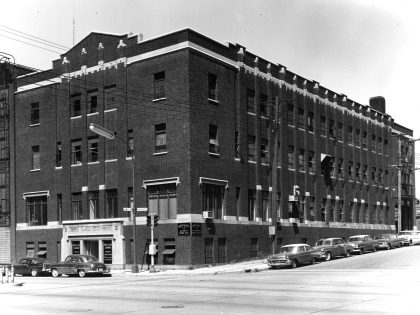
600 Washington Ave N
Brin Glass began in 1912 when Arthur Brin and his employees started working out of an aged warehouse on 1st Street North Loop, Minneapolis, Minnesota. For six years, Brin’s operations ran out of this unsuspecting location, slowly building a name for themselves and gaining public recognition. In 1918, toward the end of World War I, Brin relocated to a larger, custom-built warehouse at 600 Washington Avenue North. Today, that same building houses Black Sheep Pizza, Hook Agency, and IN Food Marketing and Design.
Brin started in an era before modern modes of transportation, so Arthur Brin and his team relied on river barges and railcars to deliver sheet glass to warehouses. The process was arduous and took two days to unload the glass from the barges to the warehouse by truck. Hay was often used to cushion the glass while in transport. In this era, every glass modification including cutting, beveling, edging, sandblasting, and fabrication was done by hand.
Though the glass, glazing, and fabrication industry was important to Arthur, it was not his sole focus in life. Arthur and his wife Fanny headed multiple charity groups and played a significant role in the Minneapolis community. For a time, Arthur was president of the Minneapolis Community Chest and also president of the Minneapolis Council of Social Agencies. Both organizations have since dissolved but have modern-day ties to the nonprofit organization United Way of Central Minnesota.
Fanny was focused on serving the poor and participating in the women’s right to vote movement. Her work caught the eye of First Lady Eleanor Roosevelt, and Fanny soon became a part of the national women’s panel on the “Mobilization For Human Needs.” During World War II, both Arthur and Fanny were actively involved in the German Jewish Children’s Aid Program (GJCAP). To keep children safe, the GJCAP would place European children in Jewish-American households until the war was over. At one point, the Brin family even took in a little boy and raised him as their own until the war was over. Afterward, he was returned to his family.
During World War I, the Great Depression, and World War II, Brin Glass kept operations running, despite overwhelming odds that were often stacked against them. Into the next decades, Brin’s Minneapolis clientele included the interior windows of the IDS Tower, Multifoods Tower, and the Sears Roebuck Tower (now known as the Midtown Global Market). As the Minneapolis skyline grew upward, so did the success and recognition of Brin Glass.
A New Era: 1940s–1960s
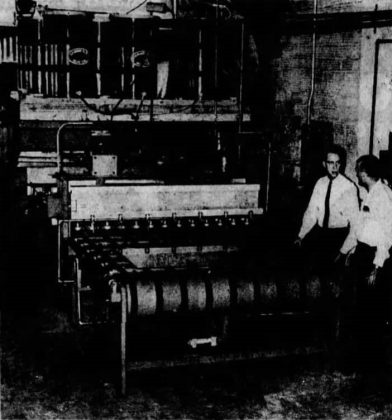
Howard Brin (Left), Herb Willy Inspect New Machine
In 1947, the Brin family suffered a tragic, unexpected loss. On November 7, 1947, Arthur died suddenly from a heart attack in his home at the age of sixty-seven. Though the couple had two other children, Rachel and Charles, Howard would become Arthur’s successor. Howard had already been working at Brin after graduating from Harvard University and serving in World War II. But due to his father’s passing, he became the president and CEO of Brin overnight. Clarence Chaney, the vice president of the 1947 Minneapolis Community Chest and Council said, “Mr. Brin’s death is a great loss to this city. He was a valuable citizen.”
Before Arthur’s death, Brin Glass had been struggling. The company needed to diversify, and Howard turned his attention to branching out into new glass fabrication ventures. In the 1950s, Brin experimented with large mirror production in particular.
Purchasing a custom-made $100,000 mirror machine in 1959 (a modern-day equivalent of $1 million), Howard began crafting both windows and mirrors for clients. In 1963, one of Brin’s clients was the Capp Towers Motor Hotel, completed with 330 outward-facing rooms. On the top of the hotel, a domed glass structure built by Brin towered over the cocktail lounge. Brin’s custom glasswork appeared in Life Magazine on July 26, 1963.
Under Howard’s leadership during the 1950s and ‘60s, Brin Glass grew to scale through organic expansion as well as acquisitions. The first major acquisition happened in 1955 when Brin acquired Northwestern Glass Company. But despite diversification and multiple acquisitions, a darker time was approaching. For the first time in Brin’s history, the company was struggling to stay afloat. Howard was growing tired of the business, and the world was changing. A new leaf was about to turn for Brin Glass.
New expansions: 1970s–2000
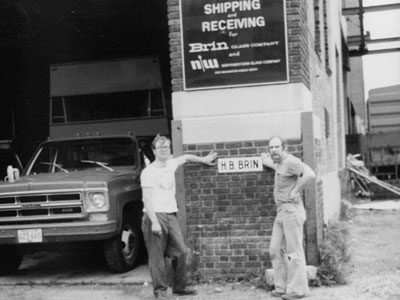
Doug Nelson (Left) and Larry Waller (Right)
Renewal and regeneration were on the horizon for Brin Glass when the company stepped into the 1970s. In 1973, former Brin-Northwestern president (2006–2016) Stan Mariska began working as a sales representative for Brin Glass as a newly graduated college student. During the first few years of Stan’s career, he began to recognize change was imminent. “The company was shrinking …by the time I knew Howard Brin, it was pretty obvious that he was on his way out of the business. He was tired of it,” Stan said. After thirty-seven years, Howard decided to sell the company and retire.
In 1978, Howard sold the company to Doug Nelson and Larry Waller, both aspiring businessmen with backgrounds in accounting and finance. Though neither had experience in the glass industry, they collected expertise from Brin employees and learned the industry first-hand. In an article entitled, “100 Years! Brin-Northwestern Glass Celebrates its Anniversary,” Mike Schmaltz, Minnesota Glass Association president in 2012, said, “I have seen Doug in a blue shirt working in the warehouse; hands-on and up close; he preferred learning from the inside out.” When Doug took a front-row seat to Brin’s operations, he realized things needed to change if Brin Glass was going to succeed.
The following year, in 1979, Doug and Larry decided to consolidate Brin and Northwestern into one company but run them as separate corporations under the name “Brin-Northwestern Glass.” Stan said, “Brin and Northwestern were similar companies in size, and they were relatively close together, but very few people knew that Brin owned Northwestern Glass. They were run very independently.” In the late 1970s, Brin also acquired St. Germain’s Glass, a Duluth glass company in business since 1891, and continued to expand their divisional branch strategy. In 1986, Brin’s former president (1996-2006), Patrick Rome, was hired as a controller at Brin-Northwestern. In an era full of new acquisitions, Patrick became a central player in Brin’s expansion alongside Bill Sullivan, Stan Mariska, and Doug Nelson. He said, “I acted as the chief financial officer from ‘86 to’95, and during that time, I also assumed the position of chief operating officer. I ran the operations.”
In 1990, Doug acquired Heartland Glass Company in Waite Park near St. Cloud. The same year, Doug promoted Bill Sullivan (future CEO), an employee of Brin since 1984, to operate as general manager of Heartland Glass.
Employee Stock Ownership Program and Leadership Changes: 2000–2023
In 2007, Bill, who had been managing Heartland since 1990, bought the Heartland Glass division from Doug and ran the company independently. Sullivan said, “We remained a customer of Brin-Northwestern Glass, and Doug continued to be my mentor, and I saw him on almost a monthly basis.” But unfortunately, the 2008 economic crisis threatened to slow down operations. Speaking about Heartland Glass, Bill said, “The next couple of years was the Great Recession. Our revenues were cut in half, and we had to lay off people…but we survived.”
At that point, Doug began to see the end of his career at Brin Glass and began planning for the future. Bill recalled the day that Doug pulled him aside and said, “I’m looking for a successor, and I think you’d be a good successor.” That conversation was a spark, and in 2013, Brin Glass formed an employee stock ownership program (ESOP) and merged again with Heartland Glass Company. At that point, Bill joined the senior leadership team for Brin.
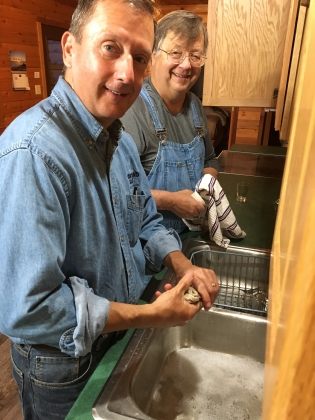
Bill Sullivan (Left), Doug Nelson (Right)
In 2016, Bill became president, initiating the start of Doug’s retirement. The ESOP program sparked significant growth for Brin, prompting Doug to relocate distribution and fabrication operations to Fridley, Minnesota—ushering in even more changes for the company. The parent company returned to the original Brin Glass Company name, inclusive of the contract and service teams in Minneapolis. With this change, the Brin family of companies had expanded to four locations: Brin Glass Company, Northwestern Glass Fab, Heartland Glass, and St. Germain’s Glass.
In 2017, Doug was unexpectedly diagnosed with terminal cancer. But despite the diagnosis, Doug continued on in the same spirit he always had. Bill said, “He never missed a day of work.” Doug continued to work in the office up until six months before his passing on May 8, 2019.
In an article entitled, “Remembering Doug Nelson of Brin Glass,” by USGlass Magazine, John Dwyer, president of Syracuse Glass, said, “I last saw him at his retirement party in June of 2018, he was fatigued by his illness, but even so, was the life of the party, trading jabs and sharing funny stories with his partners in various businesses he’d had over the years. Many of us glass guys and gals will miss Doug.”
Doug spearheaded the leadership of Brin Glass with a humble heart and a determined spirit. Patrick said, “Nothing was beneath Doug to do. If something needed to be done, hauling material, fixing something that was broken, and he was a hands-on guy—so that was really his forte in that area.”
In a Star Tribune article entitled, “Doug Nelson, whose Brin Glass had a role in Skyways and IDS Center, dies at 74,” Patrick Kennedy writes, “The biggest part of Brin Glass’ succession plan as Doug contemplated retirement was establishing an employee stock ownership plan (ESOP) in 2013 for the non-unionized employees of the company. For the union employees, he helped establish a union pension fund, bonus program and health and wellness programs.” Today, Brin is 70 percent employee-owned and continues to blend ESOP and union teams in one purpose.

Doug Nelson
After Doug’s passing in 2019, Bill took on the role of CEO at Brin. Later that year in December, Bill was voted the MVP in the Glass and Glazing Industry by Max Perilstein from Glass Magazine. Perilstein writes, “With his role in the Brin world, Bill touches so many aspects of our industry and he does it with care and class. He is always looking for ways to improve and innovate and then is not hesitant at all to share best practices with others.” Bill carried Doug’s passion for the business and people forward, honoring his mentor.
Though unaware at the time, Brin was entering another new era that would bring unprecedented challenges. As 2020 struck and the global pandemic hit, shockwaves trembled through the company from top to bottom. Across the nation, the glass and glazing industry was facing hardship. From price hikes and supply issues to labor and personnel changes, Brin was met with increasing difficulties. But through it all, Bill kept his focus on the people of Brin. In an article by BizJournals.com entitled, “What Twin Cities Execs Think it Takes to Lead for Tomorrow,” Bill was quoted, “We’ve recognized the importance of supporting our team more than we ever did before, particularly in helping employees manage their work-life balances. Some employees used to work 60 to 70 hours in a week, but we told them if they couldn’t get it done within a normal workweek that we would communicate that to the customer. The customer may not like to hear it, but they respect the answer.” Through the pandemic, Brin learned how to adapt to challenges and arrive on the other side stronger than ever.
The Succession Plan Begins: Priscilla Koeckeritz

Bill Sullivan (Left), Prisicalla Koeckeritz (Right)
In January of 2024, Bill Sullivan publicly announced the first stage of his succession plan. Priscilla Koeckeritz was named as president of Brin Glass, marking the first female president for Brin. Coming in with a vast background in leadership roles, Priscilla’s expertise centers on both marketing and operations strategy. At her core, Priscilla (known as “PK” to the team) is a passionate problem-solver whose heart is in developing people.
In an exclusive Brin interview, Bill and Priscilla sat down to share their perspectives and memories on her journey to Brin. When Priscilla first joined Brin in January of 2021, her role as a chief marketing officer helped establish Brin’s marketing strategy. Soon after, the team began to harness her multi-industry expertise, and her role expanded. Priscilla said, “That first year was an adventure …it was really fun to get to build that [Brin’s marketing]. A little over a year later, I was in the weeds on all kinds of projects, operations processes, even getting into some of the financial rhythms.”
After several months of attending senior team leadership meetings, Bill knew Priscilla’s skillset was a perfect fit for a larger role at Brin.
One meeting in particular would change the course of Priscilla’s journey at Brin. Bill reminisced, “I remember that meeting. It was the ‘What if’ meeting. ‘What if’ you had an expanded role? ‘What if’ you replaced me someday?” After the meeting, both Bill and Priscilla took time to process their expectations as individuals. Priscilla said, “We each made lists of what we were looking for in this role. Two weeks later we put our lists side by side, and they were pretty close.” After that meeting, it was clear that Priscilla was headed for president.
Priscilla’s glass industry experience was limited, this would be a roadblock for most companies—but for Brin, it was an asset. Bill believed Priscilla’s lack of industry experience would be a strength. “Often, myself included, we get down in the weeds too much,” he said. “We needed somebody to be at the thirty-thousand-foot level to take us to our growth opportunities that we planned for the future …we have a big goal of being $100 million in revenue in eight years, and she has the power to get us there.”
A New Perspective: Priscilla Koeckeritz, president and CEO of Brin Glass
In January 2025, Brin unfolded the second part of Bill’s succession plan. A year after taking on the role as the president of Brin Glass, Priscilla assumed the role of CEO. The Brin team welcomed the succession plan with great excitement and eager support. Bill said, “I’m really confident that she’ll be able to take the torch and set Brin on the path to success for many years.” Speaking specifically about the transition, Bill said, “I felt that at this time in our history we needed somebody like PK to take over the reins.”
In the leadership transition from Bill to Priscilla, perspective became pivotal. Brin’s success wasn’t dependent on industry knowledge alone, but upon the management, care, and comradery of its people. Cary Foss, Senior Sales Representative at Brin Glass Company, said, “For a long time we’ve been focused on what Brin does, and to bring somebody in that has a totally different mindset will bring us to that next phase. Brin can do glass very, very well. But the other aspects, we are old school, in technology and marketing…to get to that next step, it does require a different mode of thinking. And I see that in bringing in PK.”
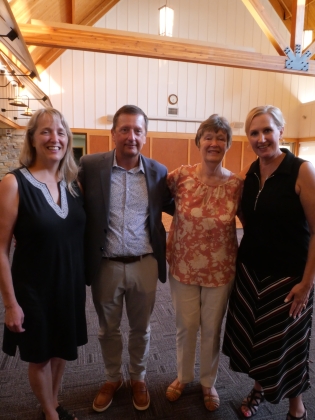
Bill and PK with the Nelson Family
For many Brin team members, Priscilla’s transition to president and CEO echoed a nostalgic remembrance of the past. Heather Pavlas, Inside Sales and Support Manager at Northwestern Glass Fab, said, “What Doug did to Bill, Bill did to PK. Some of these things that have naturally happened between Doug and Bill are now happening between Bill and PK. It’s exciting to see this happening again.”
Bill offered this advice to Priscilla as the transition took place, “It’s important that you recognize your teammates. You have to find your own path. We all have our own thing, and you’ve got to find your own path that is authentic to you. People see when you’re not being authentic. Be your authentic self, and you’ll be successful.”
For Bill, the succession plan and his retirement are surreal. Talking about his new role as Chairman of the Board for Brin, Bill said, “I get a lot of energy and enjoyment out of being able to help. I look forward to that. I think it’s a good transition to retirement …you know I’m not in a hurry to get out. I’m not gone. I’m still gonna be around for a while. I want to have purpose for my remaining years. Advising and mentoring PK and the rest of the leadership team is going to be a win-win.”
Reflecting on Bill’s new role Priscilla added, “That’s one of the ways Bill will be a good advisor to me. To make sure I don’t move too fast or too fiercely as we work on the vision and work on building it out. And really, the vision for the next three to five years is the vision he articulated to me when I started.”
Brin’s Employees: The Future
For more than one hundred years, Brin Glass Company has withstood every opposition that threatened to slow or shut it down. For Brin, the future is brighter than ever and opportunities are endless. Stan shared his perspective on Brin’s colossal success, “Other companies were unable or unwilling to change; Brin has been very flexible in changing. But they always stayed true to their roots,” Stan added, “Even in the old Brin era, I think they (Arthur and Howard Brin) understood that success was due to the people that work there. Over the years, they’ve had so many good people who were so loyal to the company and carried them forward.”
Looking back on Brin’s growth and expansion during the late 1970s and on, its success was due to the leadership that continually carried forward new passion and took risks. Patrick said, “Brin expanded geographically and into other businesses just because he (Doug) was willing to take on risk.” But despite massive expansions, Brin stayed true to its core beliefs by putting people first.
Because of Brin’s employees, there is no telling the limit of Brin’s future success.
Looking to the future, Priscilla plans to continue in Bill’s footsteps of people-oriented leadership. Priscilla said, “Being an ESOP, we’re employee-owned, but we’re also union strong. When I walked in at first, I thought that was going to be a difficult challenge. Our labor force is predominantly union. But when you actually get to have conversations, people are people…they bring their ideas, they bring their questions and suggestions. Bringing those people groups together, those teammates together for the betterment of the business, our customers, and our market has been really rewarding. More rewarding than I thought.”
Looking into the next eight years, Brin plans on expanding in new and exciting ways. Bill said, “I think Brin will be bigger. The Brin family of companies will have some new additions. I think we are going to be doing larger projects on the contract side. I’m really excited to see what that looks like.”
But through it all, Brin’s employees and customers stand at the center of their success. Priscilla said, “We’re committed to being better. That’s something I wake up with and come to work with every day. There will be challenges; sometimes things will be hard—people won’t always be happy. But if we commit every day to just being a little bit better, solving one thing, removing one obstacle, overcoming one hurdle, then we’ll be better.”
Brin’s legacy is built from the hands and hearts of those who pushed history forward without even knowing it. From the Minneapolis shippers who insulated their glass with hay in the 1920s, to the men and women across the Brin family of companies today, the passion for teamwork has yet to dwindle. At the center of Brin, it has always been the people, not the corporation, who have persevered through endless challenges over the last century. The future of Brin is held in the hands of its incredible leadership and employees. Here is to the next one hundred years of Brin Glass!


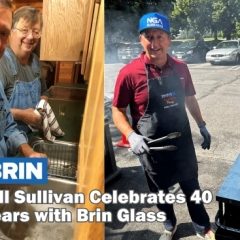

Project Manager – Metal
Customer Service Technician
ID Worker – Glazier